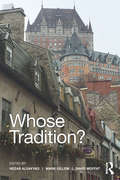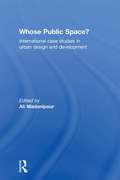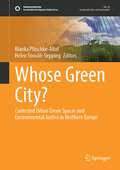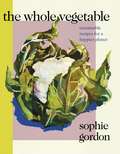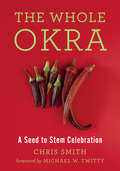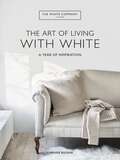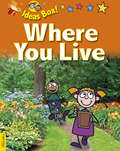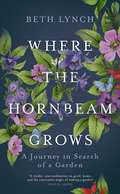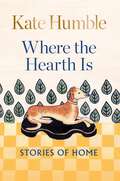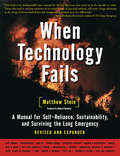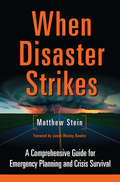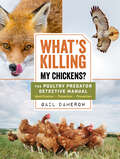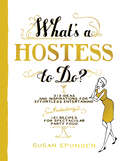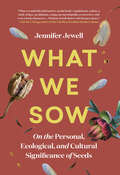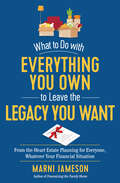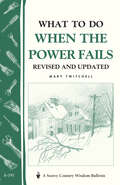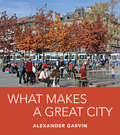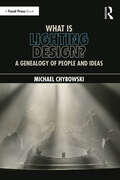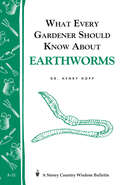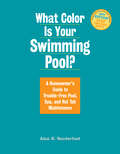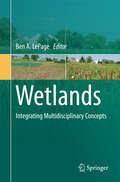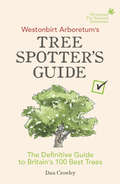- Table View
- List View
Whose Tradition?: Discourses on the Built Environment
by Nezar AlSayyad Mark Gillem David MoffatIn seeking to answer the question Whose Tradition? this book pursues four themes: Place: Whose Nation, Whose City?; People: Whose Indigeneity?; Colonialism: Whose Architecture?; and Time: Whose Identity?Following Nezar AlSayyad’s Prologue, contributors addressing the first theme take examples from Indonesia, Myanmar and Brazil to explore how traditions rooted in a particular place can be claimed by various groups whose purposes may be at odds with one another. With examples from Hong Kong, a Santal village in eastern India and the city of Kuala Lumpur, contributors investigate the concept of indigeneity, the second theme, and its changing meaning in an increasingly globalized milieu from colonial to post-colonial times. Contributors to the third theme examine the lingering effects of colonial rule in altering present-day narratives of architectural identity, taking examples from Guam, Brazil, and Portugal and its former colony, Mozambique. Addressing the final theme, contributors take examples from Africa and the United States to demonstrate how traditions construct identities, and in turn how identities inform the interpretation and manipulation of tradition within contexts of socio-cultural transformation in which such identities are in flux and even threatened. The book ends with two reflective pieces: the first drawing a comparison between a sense of ‘home’ and a sense of tradition; the second emphasizing how the very concept of a tradition is an attempt to pin down something that is inherently in flux.
Whose Public Space?: International Case Studies in Urban Design and Development
by Ali MadanipourPublic spaces mirror the complexities of urban societies: as historic social bonds have weakened and cities have become collections of individuals public open spaces have also changed from being embedded in the social fabric of the city to being a part of more impersonal and fragmented urban environments. Can making public spaces help overcome this fragmentation, where accessible spaces are created through inclusive processes? This book offers some answers to this question through analysing the process of urban design and development in international case studies, in which the changing character, level of accessibility, and the tensions of making public spaces are explored. The book uses a coherent theoretical outlook to investigate a series of case studies, crossing the cultural divides to examine the similarities and differences of public space in different urban contexts, and its critical analysis of the process of development, management and use of public space, with all its tensions and conflicts. While each case study investigates the specificities of a particular city, the book outlines some general themes in global urban processes. It shows how public spaces are a key theme in urban design and development everywhere, how they are appreciated and used by the people of these cities, but also being contested by and under pressure from different stakeholders.
Whose Public Space?: International Case Studies in Urban Design and Development
by Ali MadanipourPublic spaces mirror the complexities of urban societies: as historic social bonds have weakened and cities have become collections of individuals public open spaces have also changed from being embedded in the social fabric of the city to being a part of more impersonal and fragmented urban environments. Can making public spaces help overcome this fragmentation, where accessible spaces are created through inclusive processes? This book offers some answers to this question through analysing the process of urban design and development in international case studies, in which the changing character, level of accessibility, and the tensions of making public spaces are explored. The book uses a coherent theoretical outlook to investigate a series of case studies, crossing the cultural divides to examine the similarities and differences of public space in different urban contexts, and its critical analysis of the process of development, management and use of public space, with all its tensions and conflicts. While each case study investigates the specificities of a particular city, the book outlines some general themes in global urban processes. It shows how public spaces are a key theme in urban design and development everywhere, how they are appreciated and used by the people of these cities, but also being contested by and under pressure from different stakeholders.
Whose Green City?: Contested Urban Green Spaces and Environmental Justice in Northern Europe (Sustainable Development Goals Series)
by Bianka Plüschke-Altof Helen Sooväli-SeppingAgainst the backdrop of an accelerating global urbanization and related ecological, climatic or social challenges to urban sustainability, this book focuses on the access to “safe, inclusive and accessible green and public space” as outlined in United Nations’ Sustainable Development Goal No. 11. Looking through the lens of environmental justice and contested urban spaces, it raises the question who ultimately benefits from a green city development, and – even more importantly – who does not. While green space benefits are well-documented, green space provision is faced by multiple challenges in an era of urban neoliberalism. With their interdisciplinary and multi-method approach, the chapters in this book carefully study the different dimensions of green space access with particular focus on vulnerable groups, critically evaluate cases of procedural injustice and, in the case of Northern Europe that is often seen as forerunner of urban sustainability, provide in-depth studies on the contexts of injustices in urban greening. Chapters 1, 5, and 6 are available open access under a Creative Commons Attribution 4.0 International License via link.springer.com.
The Whole Vegetable
by Sophie GordonDiscover wholesome, sustainable and plant-based dishes in this essential cookbook for everyone from full-time vegans to those who just want to do their bit for the environment'Hearty, healthy, flavour-packed dishes' MAIL ON SUNDAY'A uniquely sustainable and delicious approach to modern plant-based cooking' VOGUE_________Have you ever wondered how to make your diet truly eco-conscious?In this beautiful plant-based cookbook, over 130 creative, delicious, planet-friendly recipes put vegetables at the very centre of the table. Embracing often-discarded parts such as leaves, stalks, tops, flowers, seeds and even peelings, this is cooking at its most sustainable.In The Whole Vegetable, Sophie Gordon shows us how to:- Cook with every part of every vegetable- Reduce waste in your cooking- Reinvent your leftovers- Eat with the seasonsFrom Cauliflower Carbonara, Broccoli Pesto and Chunky Pumpkin Tacos, to Cherry Breakfast Crumble, Maple-Roasted Pears and Apple & Walnut Danish Buns, The Whole Vegetable is packed with thoughtful recipes for every season.Most of all, it will ensure that nothing in your kitchen goes to waste._________'Creative, delicious, planet-friendly recipes . . . Teaches you how to put those often discarded parts of fruit and veg to good (and tasty) use' Women's Health'The Whole Vegetable heroes plant-based cookery, with recipes that also help reduce food waste in the kitchen and improve sustainable living. A worthwhile read' Good Housekeeping
The Whole Okra: A Seed to Stem Celebration
by Chris SmithWith recipes for gumbos and stews, plus okra pickles, tofu, marshmallow, paper, and more Chris Smith’s first encounter with okra was of the worst kind: slimy fried okra at a greasy-spoon diner. Despite that dismal introduction, Smith developed a fascination with okra, and as he researched the plant and began to experiment with it in his own kitchen, he discovered an amazing range of delicious ways to cook and eat it, along with ingenious and surprising ways to process the plant from tip-to-tail: pods, leaves, flowers, seeds, and stalks. Smith talked okra with chefs, food historians, university researchers, farmers, homesteaders, and gardeners. The summation of his experimentation and research comes together in The Whole Okra, a lighthearted but information-rich collection of okra history, lore, recipes, craft projects, growing advice, and more. The Whole Okra includes classic recipes such as fried okra pods as well as unexpected delights including okra seed pancakes and okra flower vodka. Some of the South’s best-known chefs shared okra recipes with Smith: Okra Soup by culinary historian Michael Twitty, Limpin’ Susan by chef BJ Dennis, Bhindi Masala by chef Meherwan Irani, and Okra Fries by chef Vivian Howard. Okra has practical uses beyond the edible, and Smith also researched the history of okra as a fiber crop for making paper and the uses of okra mucilage (slime) as a preservative, a hydrating face mask, and a primary ingredient in herbalist Katrina Blair’s recipe for Okra Marshmallow Delight. The Whole Okra is foremost a foodie’s book, but Smith also provides practical tips and techniques for home and market gardeners. He gives directions for saving seed for replanting, for a breeding project, or for a stockpile of seed for making okra oil, okra flour, okra tempeh, and more. Smith has grown over 75 varieties of okra, and he describes the nuanced differences in flavor, texture, and color; the best-tasting varieties; and his personal favorites. Smith’s wry humor and seed-to-stem enthusiasm for his subject infuse every chapter with just the right mix of fabulous recipes and culinary tips, unique projects, and fun facts about this vagabond vegetable with enormous potential.
The White Company The Art of Living with White: A Year of Inspiration (White Company)
by Chrissie Rucker CompanyFrom the author of the home decorating bestseller, For the Love of White, comes an inspirational and informative guide to creating a welcoming home through the seasons using a white and neutral palette.'I love a home to feel warm, inviting, personal and lived-in - and mastering how to decorate with white and neutrals is a wonderful way to achieve this.' - CHRISSIE RUCKERIn her much-anticipated second book, The Art Of Living With White, Chrissie Rucker, Founder of The White Company, explores 10 inspirational homes that illustrate beautifully different ways to use white and neutrals through the seasons. The homes vary in size, style and location - from a minimalist city pied-à-terre to a New England-style country house - but what unites them all is the welcoming, stylish and calm feel that their owners have each created.The homes are grouped into the four seasons and each chapter ends with a summary of seasonal rituals that will work in any home. A concluding chapter - Inspiration & Resources - considers finding your own style, how to create a good balance between work and home in interior spaces, the art of simple entertaining and the importance of scent and touch in a truly comfortable home.Praise for The White Company: For the Love of White'A testament to the power of neutrals' - House and Garden'A visual feast with a passion for all things white at its heart' - House Beautiful
Where You Live: Ideas Box: Where You Live Abn Espresso: Ideas Box: Where You Live (Espresso: Ideas Box #3)
by Jillian PowellJoin Sal, Ash, Scully and the rest of the Espresso team as they explore their local area. Discover how you can find out what is special about where you live, how it has changed and its famous connections. Plus make a map stick, create a picture quiz and much more!This book is part of the Espresso Ideas Box series, which have a wealth of information and ideas for exploring topics in a cross-curricular way. They are produced in association with Espresso Education, the leading digital curriculum service in the UK - used in over 10,000 primary schools.
Where the Hornbeam Grows: A Journey in Search of a Garden
by Beth LynchWhat do you do when you find yourself living as a stranger? When Beth Lynch moved to Switzerland, she quickly realised that the sheer will to connect with people would not guarantee a happy relocation.Out of place and lonely, Beth knows that she needs to get her hands dirty if she is to put down roots. And so she sets about making herself at home in the way she knows best - by tending a garden, growing things. The search for a garden takes her across the country, through meadows and on mountain paths where familiar garden plants run wild, to the rugged hills of the Swiss Jura. In this remote and unfamiliar place of glow worms and dormice and singing toads she learns to garden in a new way, taking her cue from the natural world. As she plants her paradise with hellebores and aquilegias, cornflowers and Japanese anemones, these cherished species forge green and deepening connections: to her new soil, to her old life in England, and to her deceased parents, whose Sussex garden continues to flourish in her heart. WHERE THE HORNBEAM GROWS is a memoir about carrying a garden inwardly through loss, dislocation and relocation, about finding a sense of wellbeing in a green place of your own, and about the limits of paradise in a peopled world. It is a powerful exploration by a dazzling new literary voice of how, in nurturing a corner of the natural world, we ourselves are nurtured.
Where the Hearth Is: Stories of home (Kate Humble)
by Kate HumbleKate Humble has a knack for sharing her own journey towards a more pleasing and purposeful life in a way that inspires readers, enables them to reassess their own lives and helps them achieve their personal goals. Having encouraged readers to reconnect with nature in Thinking on My Feet and simplify their lifestyles in A Year of Living Simply, she turns now to reimagining whatever we consider 'home' - examining her own experiences and expectations, ideals and memories, and considering the views of others living uniquely, extraordinarily, happily. She's gaining insights from some unexpected quarters - including the animal kingdom.As our time spent in office buildings and other traditional workplaces shrinks forevermore, feeling happy, healthy, productive and content in our homes (be they castles or caravans, flat-shares or farms, fixed or temporary, inner city/out of town/beyond) is more important to get right than ever before. Where the Hearth Is will resonate with all those seeking to make the most of their lives during the many hours we all spend at home - whether it's a case of tiny adjustments while staying put, moving out, living differently or dreaming of building something new.
When Technology Fails: A Manual for Self-Reliance, Sustainability, and Surviving the Long Emergency, 2nd Edition
by Matthew SteinThere’s never been a better time to “be prepared.” Matthew Stein’s comprehensive primer on sustainable living skills—from food and water to shelter and energy to first-aid and crisis-management skills—prepares you to embark on the path toward sustainability. But unlike any other book, Stein not only shows you how to live “green” in seemingly stable times, but to live in the face of potential disasters, lasting days or years, coming in the form of social upheaval, economic meltdown, or environmental catastrophe. When Technology Fails covers the gamut. You’ll learn how to start a fire and keep warm if you’ve been left temporarily homeless, as well as the basics of installing a renewable energy system for your home or business. You’ll learn how to find and sterilize water in the face of utility failure, as well as practical information for dealing with water-quality issues even when the public tap water is still flowing. You’ll learn alternative techniques for healing equally suited to an era of profit-driven malpractice as to situations of social calamity. Each chapter (a survey of the risks to the status quo; supplies and preparation for short- and long-term emergencies; emergency measures for survival; water; food; shelter; clothing; first aid, low-tech medicine, and healing; energy, heat, and power; metalworking; utensils and storage; low-tech chemistry; and engineering, machines, and materials) offers the same approach, describing skills for self-reliance in good times and bad. Fully revised and expanded—the first edition was written pre-9/11 and pre-Katrina, when few Americans took the risk of social disruption seriously—When Technology Fails ends on a positive, proactive note with a new chapter on "Making the Shift to Sustainability," which offers practical suggestions for changing our world on personal, community and global levels.
When Disaster Strikes: A Comprehensive Guide for Emergency Prepping and Crisis Survival
by Matthew Stein James Wesley RawlesDisasters often strike without warning and leave a trail of destruction in their wake. Yet armed with the right tools and information, survivors can fend for themselves and get through even the toughest circumstances. Matthew Stein's When Disaster Strikes provides a thorough, practical guide for how to prepare for and react in many of life's most unpredictable scenarios. In this disaster-preparedness manual, he outlines the materials you'll need-from food and water, to shelter and energy, to first-aid and survival skills-to help you safely live through the worst. When Disaster Strikes covers how to find and store food, water, and clothing, as well as the basics of installing back-up power and lights. You'll learn how to gather and sterilize water, build a fire, treat injuries in an emergency, and use alternative medical sources when conventional ones are unavailable. Stein instructs you on the smartest responses to natural disasters-such as fires, earthquakes, hurricanes and floods-how to keep warm during winter storms, even how to protect yourself from attack or other dangerous situations. With this comprehensive guide in hand, you can be sure to respond quickly, correctly, and confidently when a crisis threatens.
What's Killing My Chickens?: The Poultry Predator Detective Manual
by Gail DamerowIn this detective manual for the poultry owner, best-selling author and chicken expert Gail Damerow shows chicken keepers how to identify which predators are likely to be troubling their flock from the clues left behind, and offers proven strategies for protecting poultry.
What's a Hostess to Do?: 313 Ideas And Inspirations For Effortless Entertaining
by Susan Spungen313 Ideas and Inspirations for Effortless Entertaining, Including 121 Recipes for Spectacular Party Food
What You Need to Know about Japanese Knotweed: A UK guide for the non-specialist
by Jim GlaisterThis handy pocketbook separates fact from fiction about the invasive weed, Japanese knotweed, If you have the plant in your garden, or your neighbour has, this book will advise what to do. Typical questions asked by members of the public are: Why is knotweed such a menace? Will Japanese knotweed prevent me from selling my property? Dare I buy a property with knotweed growing on it? Can I get a mortgage on property that has knotweed in the garden? What shouldn't I do to Japanese knotweed? Will this weed reduce a house to rubble? Can I ignore it when building a patio or onto the house? What options are available for controlling knotweed? Can I actually identify it? How does it spread? What are my legal responsibilities regarding knotweed? Where can I find impartial advice?
What We Sow: On the Personal, Ecological, and Cultural Significance of Seeds
by Jennifer JewellAn insightful, personal, and timely exploration into the wonderful world of seeds. In What We Sow, Jennifer Jewell brings readers on an insightful, year-long journey exploring the outsize impact one of nature's smallest manifestations—the simple seed. She examines our skewed notions where "organic" seeds are grown and sourced, reveals how giant multinational agribusiness has refined and patented the genomes of seeds we rely on for staples like corn and soy, and highlights the efforts of activists working to regain legal access to heirloom seeds that were stolen from Indigenous peoples and people of color. Throughout, readers are invited to share Jewell's personal observations as she marvels at the glory of nature in her Northern California hometown. She admires at the wild seeds she encounters on her short daily walks and is amazed at the range of seed forms, from cups and saucers to vases, candelabras, ocean-going vessels, and airliners. What We Sow is a tale of what we choose to see and what we haven't been taught to see, what we choose to seed and what we choose not to seed. It urgently proves that we must work hard to preserve and protect the great natural diversity of seed.
What to Do with Everything You Own to Leave the Legacy You Want: From-the-Heart Estate Planning for Everyone, Whatever Your Financial Situation
by Marni JamesonFrom the author of bestselling, award-winning books on downsizing your home, here now is an all-in-one estate-planning guide for everyone, from those with little to those with much—all you need to know and do to make a difference in the lives of those you love and on the world, and turn whatever you possess into an intentional, meaningful legacy
What to Do When the Power Fails: Storey's Country Wisdom Bulletin A-191 (Storey Country Wisdom Bulletin)
by Mary TwitchellSince 1973, Storey's Country Wisdom Bulletins have offered practical, hands-on instructions designed to help readers master dozens of country living skills quickly and easily. There are now more than 170 titles in this series, and their remarkable popularity reflects the common desire of country and city dwellers alike to cultivate personal independence in everyday life.
What Makes a Great City
by Alexander GarvinThis volume will help readers understand that any city can be changed for the better and inspire entrepreneurs, public officials, and city residents to do it themselves.
What Is Lighting Design?: A Genealogy of People and Ideas
by Michael ChybowskiWhat Is Lighting Design?: A Genealogy of People and Ideas explains what lighting design is by looking at the history of ideas that are a part of this craft and how those ideas developed. Lighting design began in the West with the Renaissance, and each historical period since then has modified how and why light is used in performance, the methods for producing light, and the consensus around what its purpose is. Exploring each lighting design era and the basic components of lighting design, the book discusses how the central ideas of this craft developed over the past 500 years, what today’s lighting designers are concerned with, and how lighting design contributes to performances. This book is designed as a main course text for History of Lighting Design university courses and a supplementary text for and Introduction to Lighting Design, Stagecraft, and Scenography courses. It will also be of interest to directors, choreographers, and working lighting designers who wish to explore the history and meaning of their craft.
What Is Lighting Design?: A Genealogy of People and Ideas
by Michael ChybowskiWhat Is Lighting Design?: A Genealogy of People and Ideas explains what lighting design is by looking at the history of ideas that are a part of this craft and how those ideas developed. Lighting design began in the West with the Renaissance, and each historical period since then has modified how and why light is used in performance, the methods for producing light, and the consensus around what its purpose is. Exploring each lighting design era and the basic components of lighting design, the book discusses how the central ideas of this craft developed over the past 500 years, what today’s lighting designers are concerned with, and how lighting design contributes to performances. This book is designed as a main course text for History of Lighting Design university courses and a supplementary text for and Introduction to Lighting Design, Stagecraft, and Scenography courses. It will also be of interest to directors, choreographers, and working lighting designers who wish to explore the history and meaning of their craft.
What Every Gardener Should Know About Earthworms: Storey's Country Wisdom Bulletin A-21 (Storey Country Wisdom Bulletin)
by Henry HoppSince 1973, Storey's Country Wisdom Bulletins have offered practical, hands-on instructions designed to help readers master dozens of country living skills quickly and easily. There are now more than 170 titles in this series, and their remarkable popularity reflects the common desire of country and city dwellers alike to cultivate personal independence in everyday life.
What Color Is Your Swimming Pool?: A Homeowner's Guide to Trouble-Free Pool, Spa, and Hot Tub Maintenance
by Alan SanderfootKeep your swimming pool, spa, or hot tub clean and inviting with beautiful sparkling water. Covering all essential maintenance procedures, this easy-to-use guide shows you how to expertly and inexpensively care for your backyard water features. With advice on everything from basic cleaning routines to doing your own repairs, Alan E. Sanderfoot tells you what you need to know about water filtration systems, pumps, motors, heaters, winterizing, and more. Enjoy the pleasures of healthy, crystal-clear water for less money and less trouble! This publication conforms to the EPUB Accessibility specification at WCAG 2.0 Level AA.
Wetlands: Integrating Multidisciplinary Concepts
by Ben A. LePageThe science of wetlands and our understanding of these complex ecosystems have improved considerably. The emergence of multidisciplinary strategies is providing new opportunities and innovative approaches to address issues such as climate change and coastal protection. This book, with contributions from 19 specialists from academia, government, and industry, provides a trans-disciplinary approach to the understanding wetlands science, drawing together a wide range of expertise. Topics covered include the physical aspects that shape different wetlands around the world, as well as wetlands ecology, regulation, policy, and related social and economic issues.Featuring contributions from some of the world’s leading wetlands researchers and practitioners, this book provides an invaluable resource for undergraduate and post-graduate training in all aspects of wetlands management, conservation, and construction. It is also a useful auxiliary text for researchers working across disciplines in fields such as wetlands science, law, landscape architecture, environmental engineering, conservation ecology, and related disciplines.
Westonbirt Arboretum’s Tree Spotter’s Guide: The Definitive Guide to Britain’s 100 Best Trees
by Dan CrowleyIn the depths of the Cotswolds, near Tetbury in Gloucestershire, lies one of the most beautiful tree gardens in the world, known as Westonbirt Arboretum. Here you can find around 15,000 trees, each one lovingly labelled. They offer the perfect, picturesque setting for escaping from the pressures of everyday life.Now, for the first time, 100 of the most popular British trees form the basis of this beautiful pocket guide. Illustrated with artwork depicting the tree and leaf, this covetable little book will educate and entertain with wonderfully concise text by one of the world’s leading tree experts from the Arboretum. Pop this book in your pocket for a great day out spotting some of the most celebrated features of our landscape!
